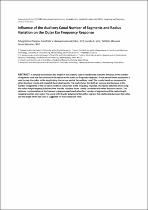 ResearchSpace
ResearchSpace
Influence of the auditory canal number of segments and radius variation on the outer ear frequency response
JavaScript is disabled for your browser. Some features of this site may not work without it.
- ResearchSpace
- →
- Research Publications/Outputs
- →
- Conference Publications
- →
- View Item
| dc.contributor.author |
Thejane, T

|
|
| dc.contributor.author |
Nelwamondo, Fulufhelo V

|
|
| dc.contributor.author |
Smit, Jacoba E

|
|
| dc.contributor.author |
Marwala, T

|
|
| dc.date.accessioned | 2012-10-02T12:05:36Z | |
| dc.date.available | 2012-10-02T12:05:36Z | |
| dc.date.issued | 2012-01 | |
| dc.identifier.citation | Thejane, T, Nelwamondo, FV, Smit, JE and Marwala, T. Influence of the auditory canal number of segments and radius variation on the outer ear frequency response. IEEE-EMBS International Conference on Biomedical and Health Informatics (BHI 2012), Hong Kong and Shenzhen, China, 2-7 January 2012, pp. 384-387 | en_US |
| dc.identifier.isbn | 978-1-4577-2175-5 | |
| dc.identifier.isbn | 978-1-4577-2176-2 | |
| dc.identifier.uri | http://ieeexplore.ieee.org/xpls/abs_all.jsp?arnumber=6211595&tag=1 | |
| dc.identifier.uri | http://hdl.handle.net/10204/6123 | |
| dc.description | Copyright: 2012 IEEE. This is an ABSTRACT ONLY. | en_US |
| dc.description.abstract | A lumped transmission line model of the auditory canal is modified to study the influence of the number of segments used and the variation of the radius on the outer ear frequency response. A new second order polynomial is used to map the radius to the length along the narrow part of the auditory canal. The results found are compared to other literature results and expected theoretical results. The study shows that both an increase and decrease in the number of segments of the ear canal results in a distortion in the frequency response. The results obtained when using the radius-length mapping function show that the response found closely correlates with other literature results. The optimum representation of the frequency response was found when four number of segments and the radius-length mapping function were used. The use of a third order polynomial to further improve the relationship between the radius and the length of the ear canal is suggested for future research work. | en_US |
| dc.language.iso | en | en_US |
| dc.publisher | IEEE | en_US |
| dc.relation.ispartofseries | Workflow;8414 | |
| dc.subject | Auditory canal | en_US |
| dc.subject | Outer ear frequency response | en_US |
| dc.subject | Outer ear models | en_US |
| dc.subject | Otoacoustic Emissions | en_US |
| dc.subject | Outer ear | en_US |
| dc.subject | Analog Model | en_US |
| dc.subject | Resonance | en_US |
| dc.title | Influence of the auditory canal number of segments and radius variation on the outer ear frequency response | en_US |
| dc.type | Conference Presentation | en_US |
| dc.identifier.apacitation | Thejane, T., Nelwamondo, F. V., Smit, J. E., & Marwala, T. (2012). Influence of the auditory canal number of segments and radius variation on the outer ear frequency response. IEEE. http://hdl.handle.net/10204/6123 | en_ZA |
| dc.identifier.chicagocitation | Thejane, T, Fulufhelo V Nelwamondo, Jacoba E Smit, and T Marwala. "Influence of the auditory canal number of segments and radius variation on the outer ear frequency response." (2012): http://hdl.handle.net/10204/6123 | en_ZA |
| dc.identifier.vancouvercitation | Thejane T, Nelwamondo FV, Smit JE, Marwala T, Influence of the auditory canal number of segments and radius variation on the outer ear frequency response; IEEE; 2012. http://hdl.handle.net/10204/6123 . | en_ZA |
| dc.identifier.ris | TY - Conference Presentation AU - Thejane, T AU - Nelwamondo, Fulufhelo V AU - Smit, Jacoba E AU - Marwala, T AB - A lumped transmission line model of the auditory canal is modified to study the influence of the number of segments used and the variation of the radius on the outer ear frequency response. A new second order polynomial is used to map the radius to the length along the narrow part of the auditory canal. The results found are compared to other literature results and expected theoretical results. The study shows that both an increase and decrease in the number of segments of the ear canal results in a distortion in the frequency response. The results obtained when using the radius-length mapping function show that the response found closely correlates with other literature results. The optimum representation of the frequency response was found when four number of segments and the radius-length mapping function were used. The use of a third order polynomial to further improve the relationship between the radius and the length of the ear canal is suggested for future research work. DA - 2012-01 DB - ResearchSpace DP - CSIR KW - Auditory canal KW - Outer ear frequency response KW - Outer ear models KW - Otoacoustic Emissions KW - Outer ear KW - Analog Model KW - Resonance LK - https://researchspace.csir.co.za PY - 2012 SM - 978-1-4577-2175-5 SM - 978-1-4577-2176-2 T1 - Influence of the auditory canal number of segments and radius variation on the outer ear frequency response TI - Influence of the auditory canal number of segments and radius variation on the outer ear frequency response UR - http://hdl.handle.net/10204/6123 ER - | en_ZA |





